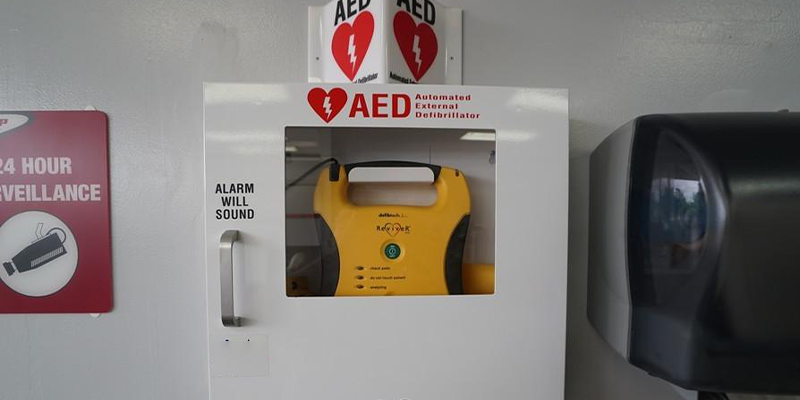According to the American Heart Association, there are more than 356,000 out-of-hospital cardiac arrests annually in the U.S. That is almost 1,000 people per day – and a startling 90% of these events are fatal. Being trained in using an AED can save a life.

Sudden cardiac arrest is the abrupt loss of heart function, breathing, and consciousness. The arrest typically results from a disruption in the heart’s electrical system. When there is a problem with the heart’s pumping action, blood flow is interrupted. These sudden arrests aren’t the same as a heart attack, which is a result of the blood flow to the heart being blocked.
If not treated immediately, sudden cardiac arrest is often fatal. However, fast and appropriate medical care can save a life. Efforts such as cardiopulmonary resuscitation (CPR), using a defibrillator, or chest compressions can keep someone alive until emergency workers arrive.
Symptoms of Sudden Cardiac Arrest:
Sudden cardiac arrest may have occurred if the individual experiences:
- Sudden collapse
- No pulse
- No breathing
- Loss of consciousness
Symptoms that may manifest just prior to sudden cardiac arrest include:
- Chest discomfort
- Shortness of breath
- Weakness
- Fluttering or heart palpitations
When the heart stops beating, the lack of oxygen-rich blood can result in death or permanent brain damage within minutes. Time is of the essence when an unconscious person isn’t breathing. If you come across an unconscious individual with labored breathing, do the following:
- Call 911 or emergency medical help
- Perform CPR. If you haven’t been trained in CPR, perform chest compressions at the rate of 100 to 120 compressions a minute. If you are certified in CPR, check the individual’s airway and perform rescue breaths after every 30 compressions.
- Continue until a portable defibrillator is available or emergency workers arrive.
AEDs and Portable Defibrillators
Portable automated external defibrillators (AEDs) are available in many public locations, including airports and shopping malls. They are also available for purchase for your home. AEDs are equipped with built-in instructions for their use. They are programmed to permit a shock only when needed.
- The defibrillator will assess the individual’s heart rhythm and advise a shock if appropriate. Deliver one shock if recommended by the device and then resume CPR, starting with chest compressions, or give chest compressions only, for about two minutes.
- Using the defibrillator, check the person’s heart rhythm once again. If needed, the defibrillator will deliver another shock. Repeat this cycle until the individual recovers consciousness or emergency workers take over.
- AEDs are designed to be easy to use in stressful medical emergencies. Both semi-automatic and fully-automatic AEDs provide users with an easy-to-use defibrillator during sudden cardiac arrest events.
- AEDs are excellent defibrillators for first responders, home emergencies, small business owners, government entities, and even corporations.
Get the Training You Need
Best Chance CPR and First Aid Training provide AED training along with CPR and first aid courses. If you live with people at risk or own a business, it may be prudent to obtain an AED and obtain proper training. Our team is happy to provide training to professional organizations and interested individuals.
None of us know when we may be placed in a life-threatening situation, and having the right training can give us peace of mind that we may be able to save a life. For more information on classes and training, call Best Chance CPR and First Aid Training today.

